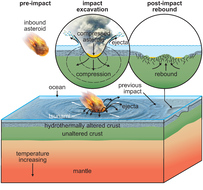Research reveals giant meteorite impacts produced Earth’s first continental crust.
| Date: | Thursday, 11 August 2022 |
|---|
Research led by Western Australian scientists reveals giant meteorite impacts produced Earth’s first continental crust.
The team of scientists from Curtin University, Geological Survey of Western Australia (GSWA) and University of Maryland focused on measuring the oxygen isotope compositions of the oldest granites in the Pilbara Craton using the Cameca IMS 1280 ion microprobe at the University of Western Australia.
Curtin University Associate Professor Tim Johnson, the project’s lead author, said the oldest granites in the world mainly formed around 3.9 to 3.5 billion years ago. This was towards the end of the late heavy bombardment when a large number of asteroids collided with Earth.
“The idea that continents might have formed as a result of giant meteorite impacts is not new,” Professor Johnson said.
“However, an absence of any clear supporting evidence means the theory has garnered very little support among the scientific community.”
The team’s research revealed that changes in the oxygen isotope values of Pilbara granites occurred at the same time as the accumulation of spherule beds, which are high-energy deposits formed during meteorite impact. This provides the first evidence that the giant impact theory might be correct.
“The Pilbara granites show a pattern beginning with shallow crustal melting, but becoming deeper with time. This top-down pattern is what you might expect following a giant meteorite impact” Dr Yongjun Lu from GSWA said.
Co-funded by the State Government’s Exploration Incentive Scheme (EIS), the research supports GSWA’s aim to better understand the geological evolution of Western Australia and provide comprehensive geoscience data for all land-use activities.
The research was published in the journal Nature and is the latest in a series of studies conducted by GSWA in collaboration with Curtin University, the University of Western Australia and international specialists.

